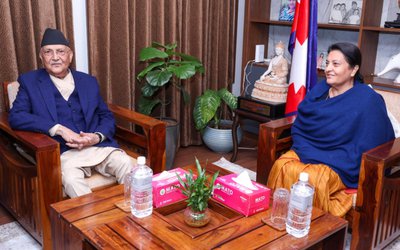Nepal launched the National Adaptation Plan (NAP) formulation process in September 2015 with a view to promote in-country preparations to address medium- and long-term adaptation needs. Recently, resources are mobilised to expedite government-led NAP formulation process with financial support from UK Aid through the Oxford Policy Management and technical support from ACT and Practical Action.
On 30 April 2016, the Ministry of Population and Environment (MoPE) – the focal point for UN Framework Convention on Climate Change (UNFCCC) -- organised a two-day orientation workshop to develop a common understanding on NAP process. Intensive interactions amongst participants provided options to make Nepal's NAP practical and implementable. Opening the workshop, Ram P. Lamsal, Joint-Secretary at MoPE and UNFCCC focal point, considered this initiative a 'corner stone' for capacity building, enriching the process, and identifying priorities. Naresh Sharma, NAP Coordinator at MoPE, informed about the previous initiatives on the NAP process and urged to extensively utilise adaptation knowledge and lessons learnt from the on-going programmes and projects. Gehendra Gurung from Practical Action informed that the technical NAP team has a greater responsibility to further identify and propose ways to address adaptation deficits.
In December 2010, Parties to the UNFCCC decided in Cancun, Mexico, to establish a process to enable LDCs to formulate and implement NAPs, building upon their experience in preparing and implementing the National Adaptation Programme of Action (NAPA). Between 2011 and 2015, Parties decisions sufficiently urged for NAP formulation in the LDCs. As of April 2016, two LDCs (Burkina Faso and Cameroon) shared their NAP through the NAP Central of the UNFCCC. Parties have also made decisions that LDCs should be supported through the LDC Fund and the Green Climate Fund to formulate and implement their NAPs.
Signed by 175 Parties to the UNFCCC, Kamal Thapa, Deputy Prime Minister and Minister for Foreign Affairs of Nepal, put his signature on the Paris Agreement on 22 April 2016 at New York. Article 7 of the Paris Agreement calls upon Parties to engage in adaptation planning processes, including a process to formulate and implement the NAPs. The Paris Agreement calls, inter alia, for assessing climate change impacts and vulnerability with a view to formulate nationally determined prioritised actions, taking into account vulnerable people, places and ecosystems.
LDCs prepared NAPAs based on Parties decision in 2001 in Marrakesh, Morocco to address most urgent and immediate adaptation needs. LDCs are implementing their NAPA-prioritised adaptation actions to build adaptive capacity of the climate vulnerable communities with support from LDC Fund, bilateral and multilateral sources. In Nepal, governmental and non-governmental organisations are implementing NAPA-prioritised adaptation actions. MoPE is implementing Nepal Climate Change Support Programme (NCCSP), popularly known as LAPA project, in 14 most climate vulnerable districts of mid- and far-west Nepal. Knowledge generated and lessons learnt from LAPA implementation and other initiatives will greatly contribute to identify and prioritise Nepal's adaptation options and needs to address climate change impacts in the medium and long terms. Experiences of the NAPA preparation, enhanced knowledge on climate change adaptation in the recent years, study findings, stakeholders' concerns and consultations, and implementation of adaptation actions will help in making Nepal's NAP practical, easy to understand and implementable to address medium- and long-term adaptation needs of the poor and climate vulnerable communities and ecosystems.
NAPA largely focused on understanding climate change and building adaptive capacity. NAP aims at reducing vulnerability to the impacts of climate change, by building adaptive capacity and resilience; and facilitating the integration of climate change adaptation, in a coherent manner, into relevant new and existing policies, programmes and activities, in particular development planning processes and strategies, within all relevant sectors and at different levels. Parties have issued initial guidelines for NAP formulation in 2011 and LDC Expert Group (LEG), as per its mandate, has developed NAP Technical Guidelines (building on initial guidelines) to assist LDCs in the NAP formulation and implementation processes.
Nepal is planning to prepare its NAP through thematic working group (TWG) approach as experienced during the NAPA preparation. A total of 7 sector TWGs (agriculture and food security; forests and biodiversity;water resources and energy; human health; climate-induced disasters; urban settlement and infrastructure; and tourism, natural and cultural heritage) and 2 cross-cutting TWGs (gender and social inclusion; and livelihood and governance), led by the senior government official of the concerned ministries, will be actively engaged in processes while formulating Nepal's NAP. Multi-stakeholder engagement in the NAP process is expected to build country capacity in addressing climate change impacts, faced by different sectors, poor people and ecosystems.
The NAP process will provide ample opportunities to integrate climate change adaptation (CCA) into national to local instruments such as policies, strategies, plans, programmes and activities of all relevant sectors. It will equally enhance understanding on CCA, develop ownership and ultimately contribute to reducing vulnerability to the impacts of climate change, build adaptive capacity and resilience, and make social and economic development climate-resilient.

Batu Uprety
Former Joint-Secretary and Chief of Climate Change Management Division, Ministry of Environment (then), and former Team Leader, National Adaptation Plan (NAP) formulation process. E-mail: upretybk@gmail.com
- Teaming up Climate Change Negotiation
- Apr 18, 2025
- Sagarmatha Sambad: Likely Bearing the Fruits
- Mar 27, 2025
- Decadal Experience In Preparing The NDC
- Mar 03, 2025
- Over Five Decades Of Concern On Air Pollution
- Jan 16, 2025
- Damaging The Functional EIA Track
- Dec 22, 2024














